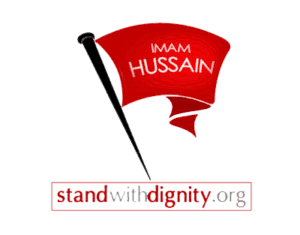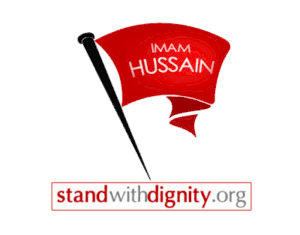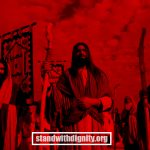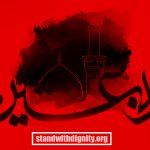The event of Karbala marks the greatest sacrifice for the sake of God in the human history. The minute and stunning details of this great event have been written and survived from the very first day by the eye witnesses.
For the last fourteen hundred centuries, the battle of Karbala reflects the collision of the good versus the evil, the virtuous versus the wicked, right versus the wrong, and the collision of Imam Hussain (the head of virtue) versus Yazid (the head of impiety).
Edward G. Brown, the professor of Arabic and oriental studies at the University of Cambridge, praises Imam Hussain in these words:
“…. A reminder of the blood-stained field of Kerbela, where the grandson of the Apostle of God fell at length, tortured by thirst and surrounded by the bodies of his murdered kinsmen, has been at any-time since then sufficient to evoke, even in the most lukewarm and heedless, the deepest emotions, the most frantic grief, and an exaltation of spirit before which pain, danger and death shrink to unconsidered trifles.”[1]
As the Imam of the time and true representative of his grandfather Prophet Muhammad (S), Imam Hussain (A) stood up against the tyrant of the time to safeguard an protect Islam and guide fellow Muslims. On the other hand, the staying power of the rulers (Muawiyah and his son Yazid) depended solely on the might of the sword. They used brute force to rule over the Muslim empire even by all possible illicit means.
Before the battle of Karbala, the world knew only the rule that “The Might is the Right”. However, the day of Ashura introduced even more powerful rule to this world; “The Right is the Might”. Now, the blood of the innocent could win over the sword of a tyrant. Mahatma Gandhi[2] writes:
“I learned from Hussain how to achieve victory while being oppressed.”
According to the great poet Rabindranath Tagore, Hussain’s sacrifice indicates spiritual liberation. He writes:
“In order to keep alive justice and truth, instead of an army or weapons, success can be achieved by sacrificing lives, exactly what Imam Hussain (A.S.) did”
Such an everlasting victory can only be achieved by the one who totally believes and trust in the Almighty God.
Thomas Carlyle[3] explains:
“The best lesson which we get from the tragedy of Karbala is that Hussain and his companions were rigid believers in God. They illustrated that the numerical superiority does not count when it comes to the truth and the falsehood. The victory of Hussain, despite his minority, marvels me”
Imam Hussain (A.S.) explains the mission of his sacrifice in his own words:
“I have taken this stand not out of arrogance or pride, neither out of mischief or injustice. I have risen to seek reform in the community of my grandfather. I would like to bid good, forbade evil, and follow the tradition of my grandfather and my father ‘All bin Abi Talib.”
Charles Dickens[4] writes:
“If Hussain had fought to quench his worldly desires… then I do not understand why his sister, wife, and children accompanied him. It stands to reason therefore, that he sacrificed purely for Islam.”
In spite of all the painful aspects of Karbala, it holds a great significance in the Islamic history, for the revolution of Imam Hussain (A) was not merely an event which had taken place by chance. It was rather a movement for the revival of Islam. Imam Hussain (A) declared his noble mission right from the day one. Antoine Bara[5] writes:
“No battle in the modern and past history of mankind has earned more sympathy and admiration as well as provided more lessons than the martyrdom of Hussain in the battle of Karbala.”
History has seen numerous massacres of innocent people, but the tragedy of Karbala is one of the few where men, women and children voluntarily allowed themselves to be subjected to hunger, thirst, humiliation and death on the burning sands of Karbala because they believed that Imam Hussain (A) stood of righteousness. Little wonder that for over 1400 years Muslims, have been nurturing the tale of Karbala in their hearts like an open wound, lest they should forget the supreme sacrifice of Imam Hussain (A) and his followers.
Great spiritual leaders are known to make great sacrifices, but at Karbala, common men and women with infants at their bosom, their hearts and souls aflame with righteousness, chose death rather than evil and weakness. Such was the greatness of Imam Hussain (A): such was his spiritual power, which could uplift common mortals to heights of supreme courage and sacrifice.
Dr. K. Sheldrake writes:
“Of that gallant band, male and female knew that the enemy forces around were implacable, and were not only ready to fight, but to kill. Denied even water for the children, they remained parched under the burning sun and scorching sands, yet not one faltered for a moment. Hussain marched with his little company, not to glory, not to power of wealth, but to a supreme sacrifice, and every member bravely faced the greatest odds without flinching.”
The tragedy of Karbala took place in 680 AD on the banks of the Euphrates in Iraq, but Karbala has a universal appeal and in today’s climate of violence, it is more relevant than ever. The tragedy of Karbala and its spirit of non-violent resistance and supreme sacrifice has been a source of inspiration to the likes of Mahatma Gandhi and Pandit Nehru.
Mahatma Gandhi’s first Salt Satyagrah was inspired by Imam Hussain’s non-violent resistance to the tyranny of Yazid. Gandhi is said to have studied the history of Islam and Imam Hussain (A), and was of the opinion that Islam represented not the legacy of a sword but of sacrifices of saints like Imam Hussain (A). Mahatma Gandhi writes:
“My faith is that the progress of Islam does not depend on the use of sword by its believers, but the result of the supreme sacrifice of Hussain (A), the great saint.”
Nehru considered Karbala to represent humanities strength and determination. He writes:
“Imam Hussain’s (A) Sacrifice is for all groups and communities, an example of the path of righteousness.”
Dr. Radha Krishna writes,
“Though Imam Hussain (a) gave his life almost 1300 years ago, but his indestructible soul rules the hearts of people even today.”
Swami Shankaracharya describes,
“It is Hussain’s (A) Sacrifice that has kept Islam alive or else in this world there would be no one left to take Islam’s name.”
Simon Ockley (1678-1720), the professor of Arabic at the University of Cambridge writes:
“The Hussain mounted his horse, and took the Koran and Laid it before him, and, coming up to the people, invited them to the performances of their duty: adding, ‘O God, thou art my confidence in every trouble, and my hope in all adversity!’.. He next reminded them of his excellencies, the nobility of his birth, the greatness of his power, and his high descent, and said, ‘Consider with Yourselves whether or not such a man as I am is not better than you: I am the son of your prophet’s daughter, besides whom there is no other upon the face of the earth. Ali was my father: Jafar and Hamza, the chief of the martyrs, were both my uncles; and the apostle of God, upon whom be peace, said both of me and my brother, that we were the chief of the youth of paradise. If you will believe me, what I say is true, for by God, I never told a lie in earnest since I had my understanding: for God hates a lie. If you do not believe me, ask the companions of the apostle of God (here he named them), and they will tell you the same. Let me go back to (from where I have come) what I have.’ They asked, ‘What hindered him from being ruled by the rest of his relations.’ He answered, ‘God forbid that I should set my hand to the resignation of my right after a slavish manner. I have recourse to God from every tyrant that does not believe in the day of account.”[6]
Ignaz Goldziher (1850-1921), the Famous Hungarian orientalist scholar writes:
“Ever since the black day of Karbala, the history of this family… has been a continuous series of sufferings and persecutions. These are narrated in poetry and prose, in a richly cultivated literature of metrologies- A Shi’a specialty- and form the theme of Shi’a gatherings in the first third of the month of Muharram, whose tenth day (‘Ashura) is kept as the anniversary of the tragedy at Karbala. Scenes of that tragedy are also presented on this day of commemoration in dramatic from (ta’ziya). ‘Our feast days are our assemblies of mourning. ‘So concludes a poem by a prince of Shi’a disposition recalling the many mihan of the Prophet’s family. Weeping and lamentation over the evils and persecutions suffered by the ‘Ali family, and mourning for its martyrs: these are things from which loyal supporters of the cause cannot cease. ‘More touching than the tears of the Shi’as has even become an Arabic proverb.”[7]
Edward Gibbon (1737-1794), considered as the greatest British historian of his time writes
“In a distant age and climate the tragic scene of the death of Hussain will awaken the sympathy of the coldest reader.”[8]
Peter J. Chelkowski, Professor of Middle Eastern Studies, New York University, writes
“Hussain accepted and set out from Mecca with his family and an entourage of about seventy followers. But on the plain of Kerbela they were caught in an ambush set by the … caliph, Yazid. Though defeat was certain, Hussain refused to pay homage to him. Surrounded by a great enemy force, Hussain and his company existed without water for ten days in the burning desert of Kerbela. Finally Hussain, the adults and some male children of his family and his companions were cut to bits by the arrows and swords of Yazid’s army; his women and remaining children were taken as captives to Yazid in Damascus. The renowned historian Abu Reyhan al-Biruni states;”… then fire was set to their camp and the bodies were trampled by the hoofs of the horses; nobody in the history of the human kind has seen such atrocities.”[9]
Reynolds Alleyne Nicholson (1868-1945), Sir Thomas Adams, Professor of Arabic at the University of Cambridge, writes,
“Hussain fell, pierced by an arrow, and his brave flowers were cut down beside him to the last man. Muhammadan tradition, which with rare exceptions is uniformly hostile to the Umayyad dynasty, regards Hussain as a martyr and Yazid as his murderer.”[10]
Robert Durey Osborn (1835-1889), the Major of the Bengal Staff Corps, writes,
“Hussain had a child named Abdallah, only a year old. He had accompanied his father in this terrible march. Touched by its cries, he took the infant in is arms and wept. At that instant, a shaft from the hostile ranks pierced the child’s ear, and it expired in his father’s arms. Hussain placed the little corpse upon the ground. ‘We come from God, and we return to Him! He cried; ‘O Lord, give me strength to bear these misfortunes!’ … Faint with thirst, and exhausted with wounds, he fought with desperate courage, slaying several of his antagonists. At last he was cut down from behind: at the same instance a lance was thrust through his back and bore him to the ground: as the dealer of this last blow withdrew his weapon, the ill-fated son of Ali rolled over a corpse. The head was severed from the trunk; the trunk was tramped under the hoofs of the victors’ horses; and the next morning the women and a surviving infant son were carried away to Kufa. The bodies of Hussain and his followers were left unburied on the spot where they fell. For three days they remained exposed to the sun and the night dews, the Vultures and the prowling animals of the waste; but then the inhabitants of a neighboring village, struck with horror that the body distortion and corruption by corrupt leaderships, but he also revived the institution of martyrdom in a world of cowardly men who were willing to bear even the utmost disgrace and indignity for their fear of death and their egotism in this world. His words echo through the long distance of centuries.”
On the sight of such sacrifice and altruism, many intellects and philosophers around the world were touched by the greatness of this man, understood the core of his mission, and grasped the essence of the school of Karbala.
72 of Imam’s kinsmen accompanied him, and all were slain in the land of Karbala to achieve righteousness. He not only gave himself up but everything possible in the way of God, including his few months old baby Ali Al Asghar, and with unyielding steadfastness.
Young and old, women, men, children and infants… inseparable despite the hunger, thirst, heat, torture, and death they were subject to.. Still unyielding, and their hearts and souls with righteousness chose death rather than evil and weakness. Such are the principles that feed and nurture the hearts of the Muslims who over the past 1400 years have been reviving the epic of Karbala.
There is a saying that “Every Land is Karbala, and every day is Ashura”, yes indeed. Hussain fought for justice, freedom, truth and enlivening human merits. But these are the same concepts we live today, those that our ancestors lived earlier, and those that generations to come will live tomorrow, because these concepts never become obsolete, never!
More on the sacrifice of Imam Hussain, Dr. Rajendra Prasad writes
“The sacrifice of Imam Hussain (A) is not limited to one country, or nation, but it is the hereditary state of the brotherhood of all mankind.”
Sarojini Naidu, a great poet writes,
“I congratulate Muslims that from among them, Hussain (A), a great human being was born, who is revered and honored totally by all communities”
Lessons provided by Imam Hussain are lessons for today, as the world lives hegemonic and colonial schemes, witnesses thousands and thousands of innocents die over wars of greed while only a few fight for virtue.
[1]A literary History of Persia, London, 1919, p. 227
[2]India’s political and spiritual leader
[3]Scottish historian and essayist
[4]English novelist
[5]Lebanese writer in Hussain in Christian Ideology
[6]The History of the Saracens, London, 1894, pp. 404-5
[7]Introduction to Islamic Theology and Law, Princeton, 1981, p. 179
[8]The Decline and Fall of the Roman Empire, London, 1911, volume 5, pp.391-2
[9]Ta’ziyeh: Ritual and Drama in Iran, New York, 1979, p.2
[10]A Literary History of the Arabs, Cambridge, 1930, p.197











